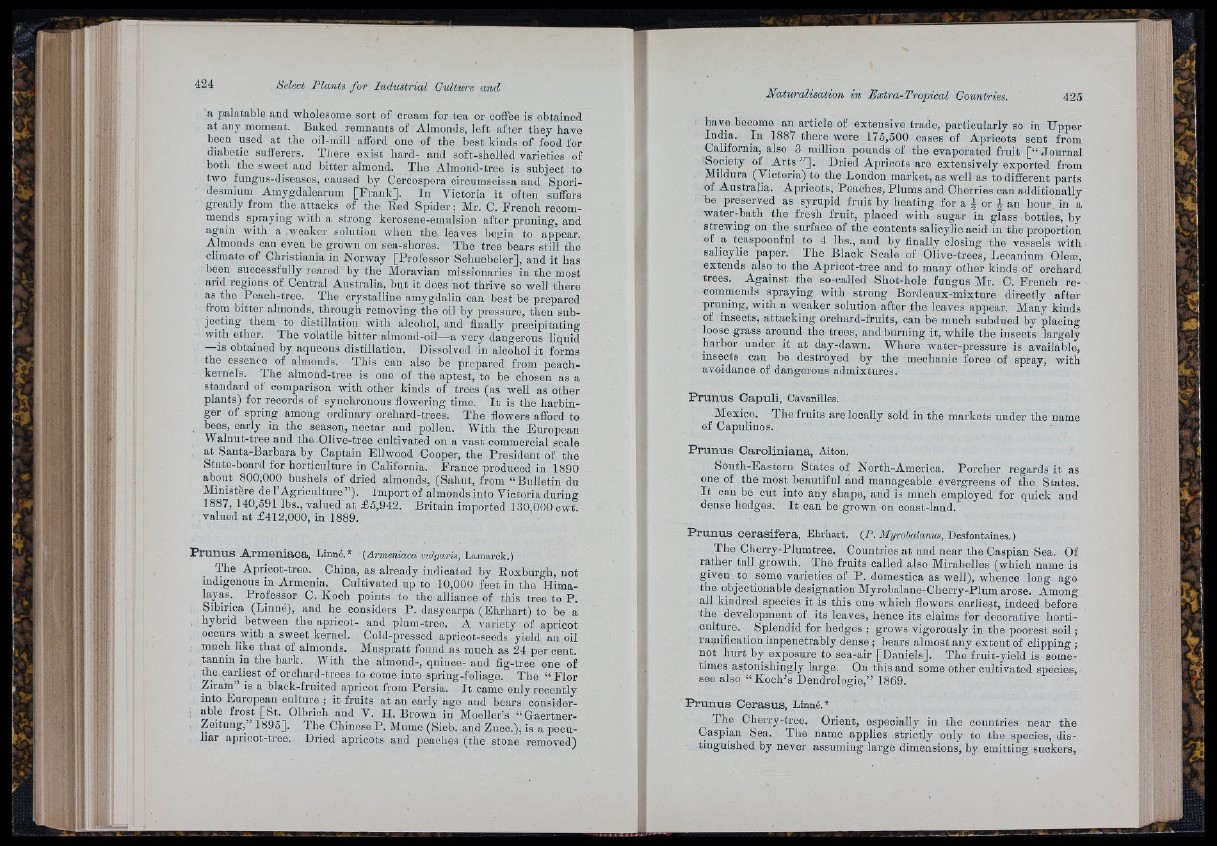
I i
| :
a palatable and wholesome sort of cream for tea or coffee is obtained
a t any moment. Baked remnants of Almonds, left after they have
been used at tbe oil-mill afford one of the best kinds of food for
diabetic sufferers. There exist bard- and soft-shelled varieties of
botli tbe sweet aud bitter almond. The Almond-tree is subject to
two fnngns-diseases, caused by Cercospora circumscissa and Spori-
desmium Amygdalearum [F ran k ]. In Victoria it often suffers
greatly from the attacks of the Red Spider ; Mr. C. French recom-
mends spraying with a strong kerosene-emulsion after pruning, and
again with a .weaker solution when the leaves begin to appear.
Almonds ^cau even be grown on sea-shores. The tree bears still the
climate of Christiania iu Norway [Professor Sohuebeler], and it has
been successfully reared by the Moravian missionaries iu the most
arid regions of Central Australia, but it does not thrive so well there
as the Peach-tree. The crystalline amygdalin can best be prepared
from bitter almonds, through removing the oil by pressure, then subjecting
them^ to distillation with alcohol, aud flually precipitating
with etlier. Ih e volatile bitter almond-oil—a very dangerous liquid
—is obtained by aqueous distillation. Dissolved in alcohol it forms
the essence of almonds. This can also be prepared from peach-
kernels. The almond-tree is one of the aptest, to be chosen as a
standard of comparison with other kinds of trees (as well as other
plants) for records of synchronous flowering time. I t is the harbinger
of spring among ordinary orchard-trees. The flowers afford to
bees, ear y in the season, neotar and pollen. With the European
Walnut-tree and the Olive-tree cultivated on a vast commercial scale
at Santa-Barbara by Captain Ellwood Cooper, the President of tlie
State-board for horticulture in California. France produced in 1890
about 800,000 bushels of dried almonds, (Sahut, from “ Bulletin du
Ministère de I’Agrionltnre” ). Import of almonds into Victoria during
1887, 140,591 lbs., valued a t £5,942. Britain imported 130,000 cwt.
valued a t £412,000, in 1889.
P m n u s A rm e n ia c a , Linné.* (Armeniaca vulgaris,'L&mavck.)
The Apricot-tree. China, as already indicated by Roxburgh, not
indigenous in Armenia. Cultivated up to 10,000 feet in the Himalayas.
Professor C. Koch points to the alliance of this tree to P.
Sibirica (Linné), and he considers P. dasycarpa (Ehrhart) to be a
, hybrid between the apricot- and plum-tree. A variety of apricot
occurs with a sweet kernel. Cold-pressed aprioot-seeds yield an oil
much like th a t of almonds. Muspratt found as much as 24 per cent,
tannin in the bark. With the almond-, quince- and flg-tree one of
the earliest of orchard-trees to come into spring-foliage. The “ Flor
Ziram” is a black-fruited apricot from Persia. I t came only recently
into European culture ; it fruits a t an early age aud bears considerable
frost [St. Olbrich aud V. H. Brown in Moeller’s “ Gaertner-
Zeitung,” 1895]. The Chinese P . Mume (Sieb. and Zucc.), is a peculiar
apricot-tree. Dried apricots and peaches (the stone removed)
have become an article of extensive trade, particularly so in Upper
India. In 1887 there were 175,500 cases of Apricots sent from
California, also 3 million pounds of the evaporated fruit [ “ Journal
Society of Arts ”] . Dried Apricots are extensively exported from
Mildura (Victoria) to the Loudon market, as well as to different parts
of Australia. Apricots, Peaches, Plums and Cherries can additionally
be preserved as syrupid fruit by heating for a | or 1 an hour in a
water-bath the fresh fruit, placed with sugar in glass bottles, by
strewing on the surface of the contents salicylic acid in the proportion
of a teaspoonful to 4 lbs., and by finally closing the vessels with
salicylic paper. The Black Scale of Olive-trees, Lecanium Olese,
extends also to the Apricot-tree and to many other kinds of orchard
trees. Against the so-called Shot-hole fungus Mr. C. French recommends
_ spraying with strong Bordeaux-mixture directly after
pruning, with a weaker solution after the leaves appear. Many kinds
of insects, attacking orchard-fruits, can be much subdued by placing
loose grass around the trees, aud burning it, while the insects largely
harbor under it at day-dawn. Where water-pressure is available,
insects can be destroyed by tbe mechanic force of spray, with
avoidance of dangerous admixtures.
P r u n u s C ap u li, Cavanilles.
Mexico. The fruits are locally sold in the markets under the name
of Capulines.
P r u n u s C a ro lin ia n a , Aiton.
South-Eastern States of North-America. Porcher regards it as
one of the most beautiful and manageable evergreens of the States.
I t can be cut into any shape, and is much employed for quick and
dense hedges. I t can be grown on coast-land.
P r u n u s c e ra s ife ra , Ehrhart. {P. Myrolcdanus,De&tontairLes.)
The Cherry-Plumtree. Countries at and near the Caspian Sea. Of
rather tall growth. The fruits called also Mirabelles (which name is
given to some varieties of P . domestica as well), whence long ago
the objectionable designation Myrobalane-Cherry-Plum arose. Among
all kindred species it is this one which flowers earliest, indeed before
the development of its leaves, hence its claims for decorative horticulture.
Splendid for hedges ; grows vigorously in the poorest soil ;
ramification impenetrably dense ; bears almost any extent of clipping ;
not hurt by exposure to sea-air [Daniels]. The fruit-yield is sometimes
astonishingly large. On tbis and some other cultivated species,
see also “ Koch’s Dendrologie,” 1869.
P r u n u s C e ra su s , Linné.*
The Cherry-tree. Orient, especially in the countries near the
Caspian Sea. The name applies strictly only to the species, distinguished
by never assuming large dimensions, by emitting suckers,